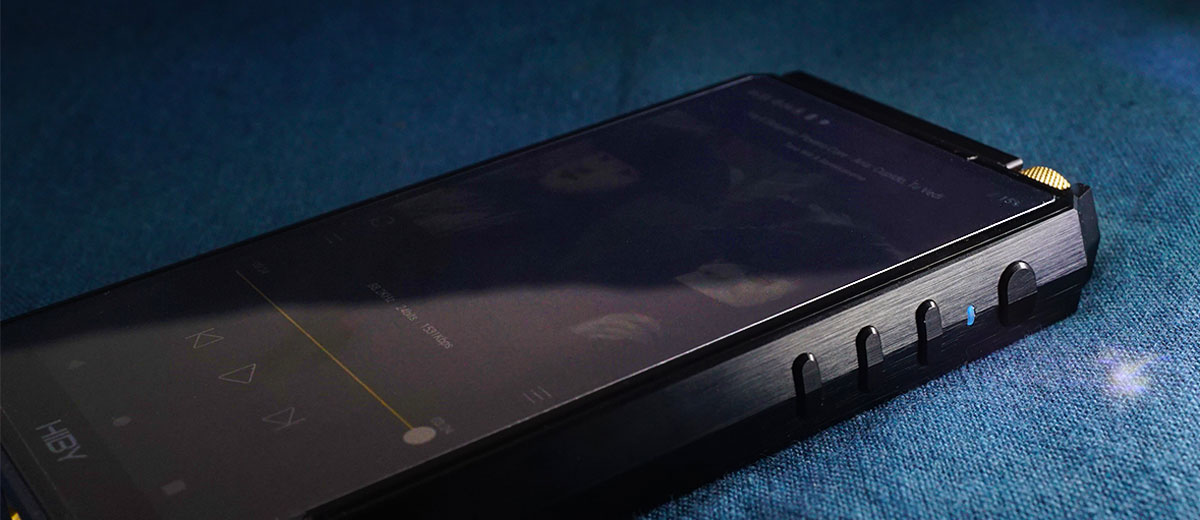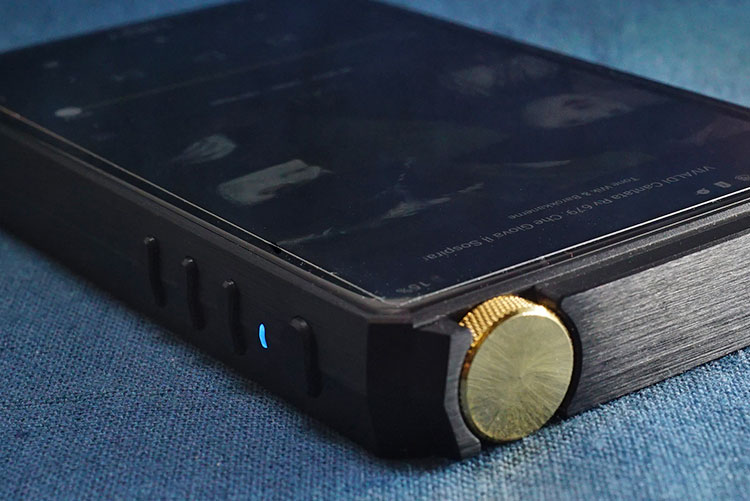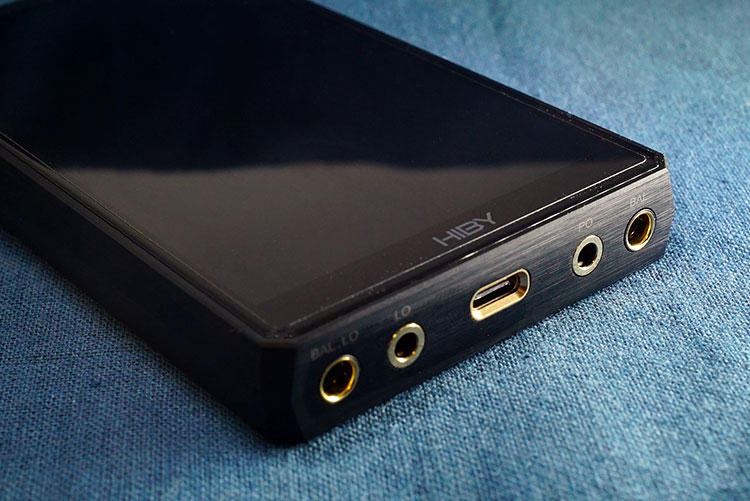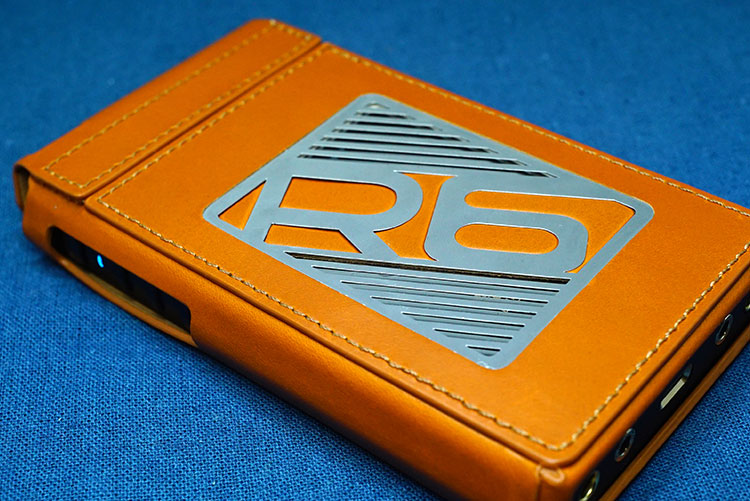Today’s review covers the HiBy R6 2020 which is an updated version of the original R6 featuring the styling of the flagship R8, and Android 9 It is priced at $799.
Disclaimer: The HiBy R6 2020 was sent to us as a sample in exchange for our honest opinion. We thank HiBy Music for this opportunity.
To learn more about HiBy products featured on Headfonics you can click here.
Note, this areticle follows our new scoring guidelines for 2020 which you can read up on here.
The new R6 2020 version feels like a complete break from the original R6 and is instead, a ‘mini-me’ of the R8 flagship DAP from the same factory, with sporty aesthetics and the same leading, mega fast UI response along with a handful of upgrades from the previous R6 Pro.
Sporting a new DAC and amping solution, Android 9, 4GB of RAM, a new snapdragon processor, and 750mW of max output, the R6 2020 is clearly improved over the R6 Pro and still below the flagship R8.
I am very intrigued as to why it isn’t called the R7 but let’s drop the confusion and move on to what this DAP can do!
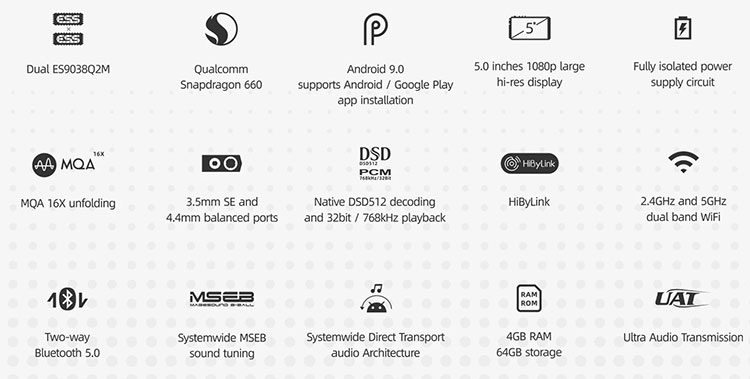
Tech Inside
Snapdragon 660 SoC
To cater for better graphics and offer BT5.0 support, HiBy offers the same Snapdragon 660 SoC clocked at 2.2GHz as we have seen in the R8.
This is incredibly fast and also more power-friendly, sporting a generous 4GB ROM that makes it extremely responsive with applications. There is zero doubt this is amongst the very fastest DAP in the market, noticeably faster than all FiiO, Shanling, iBasso, AK, and leave established names like the Sony WM1Z/A far behind.
Android 9
HiBy has extended its software competitiveness from the R8 and the R6 is the second Android 9 DAP that hits the shelves, while most competitors are still using Android 8 or even Android 7.
While the OS features are much more up to date, one of my favorite features legacy features MSEB is still there only this time it is added to the core OS architecture. This allows you to apply some easy DSP correction to the sound output of all your OS apps and not just HiBy Music.
What surprises me is that the R6 2020, (and the R8), also comes with gyro sensors so you could play gyro capable apps such as ‘Doodle Jump’ on it. This is an uncommon feature for a DAP and now on the R6 2020, the experience is more complete.

Dual ESS ES9038Q2M DAC
Following the trail of the original R6 and R6 Pro’ use of ESS’s Q2M series chipsets, the R6 2020 gets an upgrade to two pieces of ES9038Q2M with decoding capability up to DSD512 and PCM 32BIT/768kHz.
From experience, these ESS chipsets are always clean and highly detailed. There is high flexibility to shape the sound in the amping stage following the decoding.
Compared to the Pro version of the chipset the Q2M consists of fewer channels but is much more power-efficient under portable adaptations. Using the Pro version requires a lot more current draw reducing battery life considerably and increasing the risk of throttling in performance.
With HiBy’s DTA(Direct transport audio) bit-perfect architecture, the signal is free from SRC limitations and achieves a platform-wide bit-perfect output.
MQA 16X
While competition from iBasso and FiiO are using 4X and 8X unfolding capability on their current offerings, the R6 2020 offers a highly future-proofed 16X unfolding capability like the flagship R8.
This is a premium feature that is only seen on very high-end gears at this moment, for example, Cary Audio’s DMS-500, ($4995 MSRP), and allows you to stream up to 32BIT/768kHz directly with TIDAL or local MQA files where available.
Bluetooth 5.0
While we have more and more TWS earphones and receivers supporting BT5.0 many manufacturers are still stuck with controllers that support up to BT4.2 only.
The R6 2020 is one of the exceptions that offers top class BT connectivity and compatibilities like LDAC as well as their own high-speed UAT code capability at up to 192kHz sample rates and a 1.2Mbps bitrate.
You can easily notice a quality enhancement in connection quality and range as well as the playback quality when compared to the R6 Pro.
Design
Dimensions
The 130 x 73 x 15mm newly designed aluminum alloy body weighs 235g, 50g lighter than the stainless-steel body of the R6 Pro, and can be easily held and controlled single-handedly as HiBy claims.
With the R8 side by side, this is quite a bit smaller and it feels similar to the iPhone 12 Pro Max. You can easily slide the new R6 in your pants pockets with or without the leather case on, and it is just the right size and weight for a good grip.
Styling
Comparing the new R6 2020 to the original R6 is like pitching a Mustang against a Fiat. The build quality, aesthetics, and metal treatment are hugely improved from the original R6.
The bolder, edged machining feels much cooler and more modernized and so also the fancy full HD panel. Adorned by a smart golden knob that covers an ALPS potentiometer, the new R6 offers an analog user experience offered by some of the competitors, for example, Lotoo and L&P.
The slim playback controls and power button with cool lighting can be easily accessed even when the leather case is on, while the R6 2020 supports double-tapping on the screen to wake so it gets even more convenient. If you are an R6 user you will probably remember the LED indicator, consistent with HiBy’s design language.
Screen
A nearly bezel-less design with full-screen lamination makes the new R6 2020 more appealing than ever and a huge leap from the 720p of the R6 Pro. The 16:9, 5.0” 1080p Full HD screen with Corning Gorilla Glass panel offers 443ppi, very high pixel density similar to the DX220, with good sharpness and very vivid colors.
The viewing angle is very wide and the screen is clear and highly contrasted making it quite legible under the sun. Having a higher resolution screen is definitely a great advantage for better visual content viewing and web browsing.
Also, with so much CPU power under the hood, this is becoming more or less necessary for the full multimedia player experience.
I/O
Nearly identical to the R8, all inputs and outputs are located on the bottom panel, unlike the previous-gen R6 that puts the jacks on top.
The 2.5mm TRRS socket is now gone and replaced by a 4.4mm balanced LO and PO, whilst retaining a 3.5mm LO socket. I would recommend getting the DD Hifi converter for 2.5mm cables if you prefer to use cables with this termination.
As a side note, the USB-C port supports digital output for external decoders and inside the packaging, you will get a USB-C to a coaxial cable that allows you to connect to other decoders.
Battery Life
With 4500mAh under the hood, the new R6 2020 is good for up to 8 hours of playtime on balance and 10 hours on SE connection. This is 500mAh more than the R6 Pro allowing for around 7 hours playback time on its balanced output.
With the modern OS and fast response, you will not be able to resist playing with different apps and scrolling around when the screen. The battery is enough for a day’s use but can drop from the rated specs with more intense gaming, hi-res decoding, WiFi, or BT usage.
Storage
Upgrading from R6 Pro’s 32GB capacity the R6 comes with 64GB, doubling the size, and is the same as the Cayin N6ii, the FiiO M15, and iBasso’s DX220. You can use a 2TB card to expand the memory or read from OTG sources.
Packaging & Accessories
Though not as impressive as the huge leather case that comes with the R8, the R6 packaging looks cool and modern. Sliding off the sleeves you will get to a box which can be opened on the sides, the new R6 sits on one side and there is a compartment for everything else on the other side.
Accessories include a Type-C to Coaxial cable, Type-C charging cable, and two extra screen protectors. One set of screen protectors are preinstalled on the unit.
Leather case
HiBy sent us a leather case along with the unit and I really like the color on top, somehow reminding me of Maserati’s interior. The signature orange color matches well with the sporty framework design on the new R6 and spaces are carefully carved out for buttons to be clicked easily.
The case offers good protection to the volume knob, it is very unlikely to have an accidental volume bump.
The unit can be slid out at ease after you open the magic tape seal behind. You can see some space is left out at the back and it could be for heat dissipation, however, despite the design, the unit doesn’t really get hot (just warm) even when playing DSD for two hours.
Internal Hardware
Digital
The R6 2020 uses a dual ES9038Q2M configuration with a separate power supply section for the line stage with an amping stage aiming for a cleaner, more powerful dynamic range than the previous iteration.
The Q2M is the mobile version for the ES9038 DAC chip which offers a high S/N ratio with great power efficiency, merely 40mW, that is why the new R6 2020 achieves long playback hours, smaller size than the R8, and nearly 75% the output power on paper.
A wide range of codecs are supported covering the likes of APE, FLAC, MP3 MQA, WMA, AAC, ALAC, AIFF, OGG, WAV, DSF, DFF, and DXD native decoding, pretty much a complete set that will handle any common or less common files.
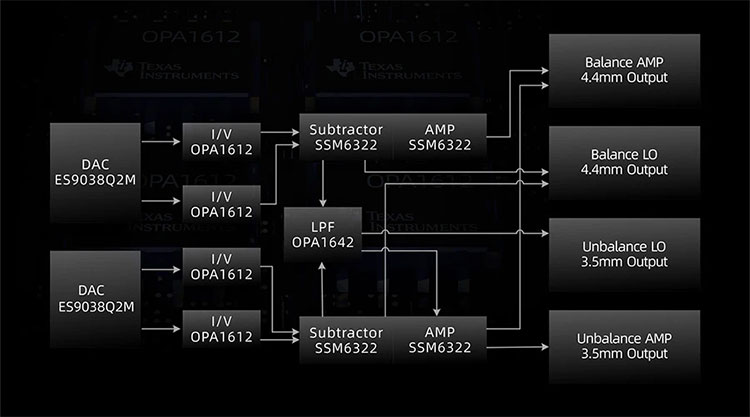
Analog
While ensuring a black background HiBy has chosen some audiophile-grade components to add to the independently powered line circuitry. Four pieces of the OPA1612 dual-channel Op Amps are used for the I/V stage to step up in dynamic range and output power.
There are also low-ESR Panasonic POSCAPs and Elna capacitors in the path, which are used on the R8 as well. We have the OPA1642 as LPF, a rather common choice and the PO outputs are further boosted by the SSM6322 that offers high output current and capability in suppressing pop and click noises.
Performance Numbers
The HiBy R6 2020 offers 750mW balanced at the highest gain level, (Turbo mode), and 245mW on SE output on a 32Ω load, which is the same figure from the original R6 Pro. Very decent numbers here.
The lineout is rated at 4V and 2V respectively on balanced and unbalanced connections. Again, we can see the manufacturer focusing on the balanced output so get your IEMs and headphones balanced if you are aiming for the best performance or the most power.
If you are an R6 Pro user you may remember the hearable noise floor that accompanied its output signal. The new R6 2020 achieves a much better noise control with the THD+N improved from 0.0012% to 0.0009% on balanced and 0.0025% to 0.001% on its SE output.
You will hear a darker background with sensitive earphones like the Shure SE846 and Campfire Audio’s Andromeda 2020. This is a comprehensive upgrade when there is more power and noise control while impedance matching is done better on the R6 2020.
The signal to noise ratio (SNR) is also enhanced to 123dB from R6 Pro’s 120dB on a balanced connection.
Click on page 2 below for software and sound impressions
Click on page 3 below for wired & wireless performance and comparisons

